UNSW BBA103: Destructive Responses to Job Dissatisfaction Analysis
VerifiedAdded on 2023/06/12
|8
|2625
|430
Essay
AI Summary
This essay explores the destructive responses of unhappy employees to job dissatisfaction, emphasizing the critical role of job satisfaction in a healthy workforce. It delves into factors contributing to dissatisfaction, such as underpayment, lack of challenges, poor company policies, and limited growth opportunities, and examines how these issues can lead to negative behaviors and decreased productivity. The essay presents a real-world example of Fuji Films to illustrate the consequences of neglecting employee needs and highlights the importance of open communication, recognition, and addressing employee concerns to foster a positive and productive work environment. The essay concludes that HR involvement and meeting employee expectations are important to mitigate negative behaviors.
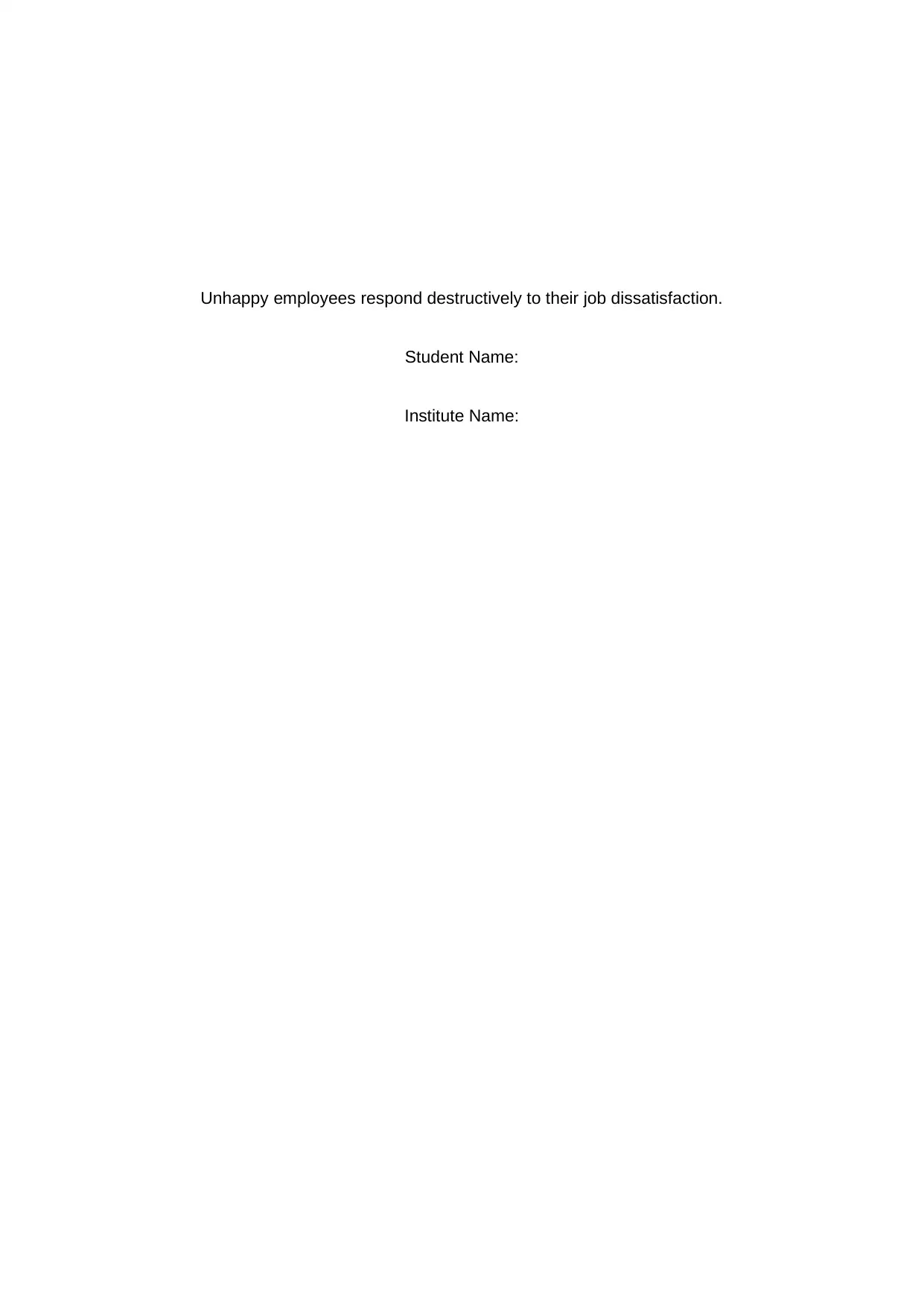
Unhappy employees respond destructively to their job dissatisfaction.
Student Name:
Institute Name:
Student Name:
Institute Name:
Paraphrase This Document
Need a fresh take? Get an instant paraphrase of this document with our AI Paraphraser
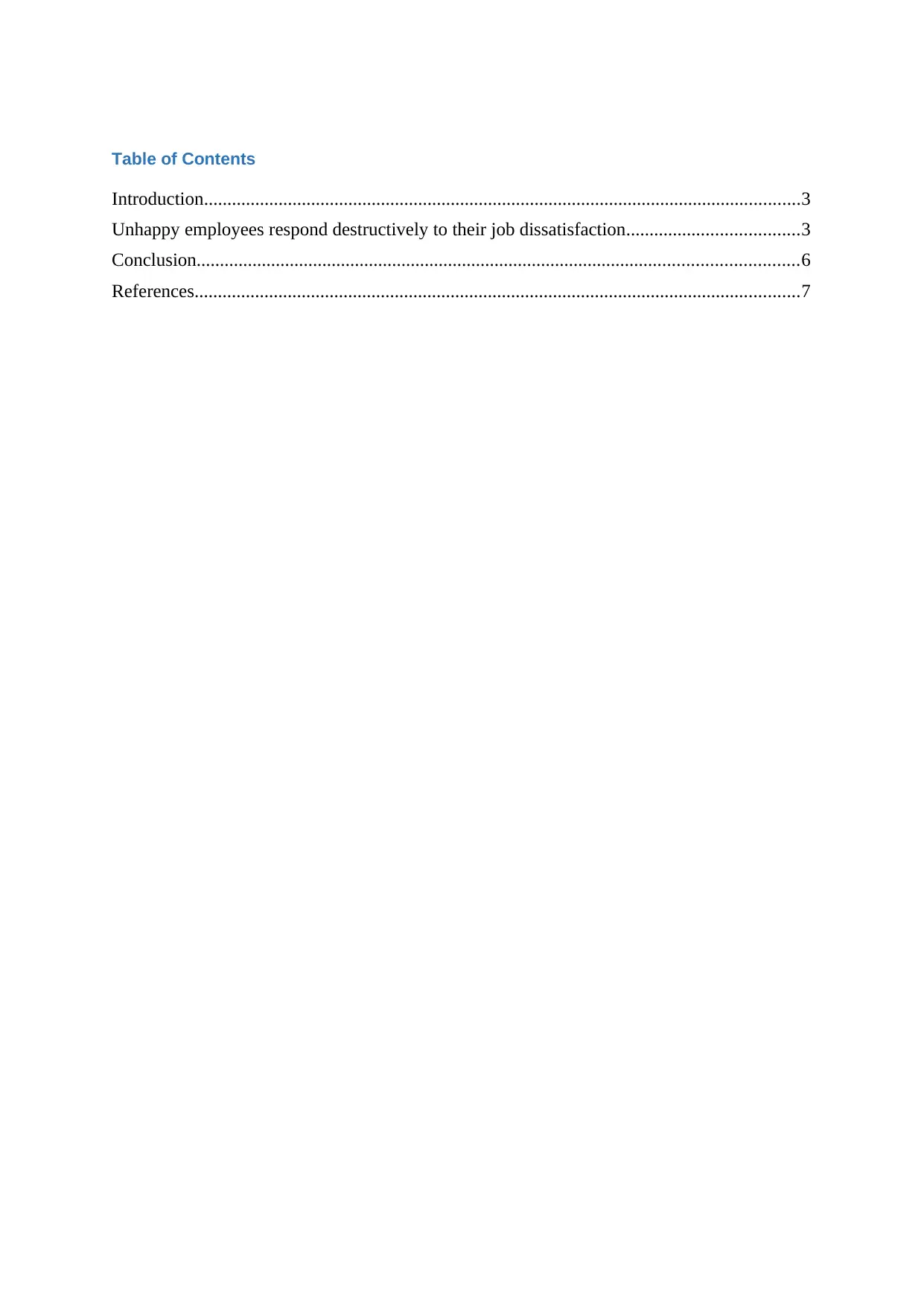
Table of Contents
Introduction................................................................................................................................3
Unhappy employees respond destructively to their job dissatisfaction.....................................3
Conclusion.................................................................................................................................6
References..................................................................................................................................7
Introduction................................................................................................................................3
Unhappy employees respond destructively to their job dissatisfaction.....................................3
Conclusion.................................................................................................................................6
References..................................................................................................................................7
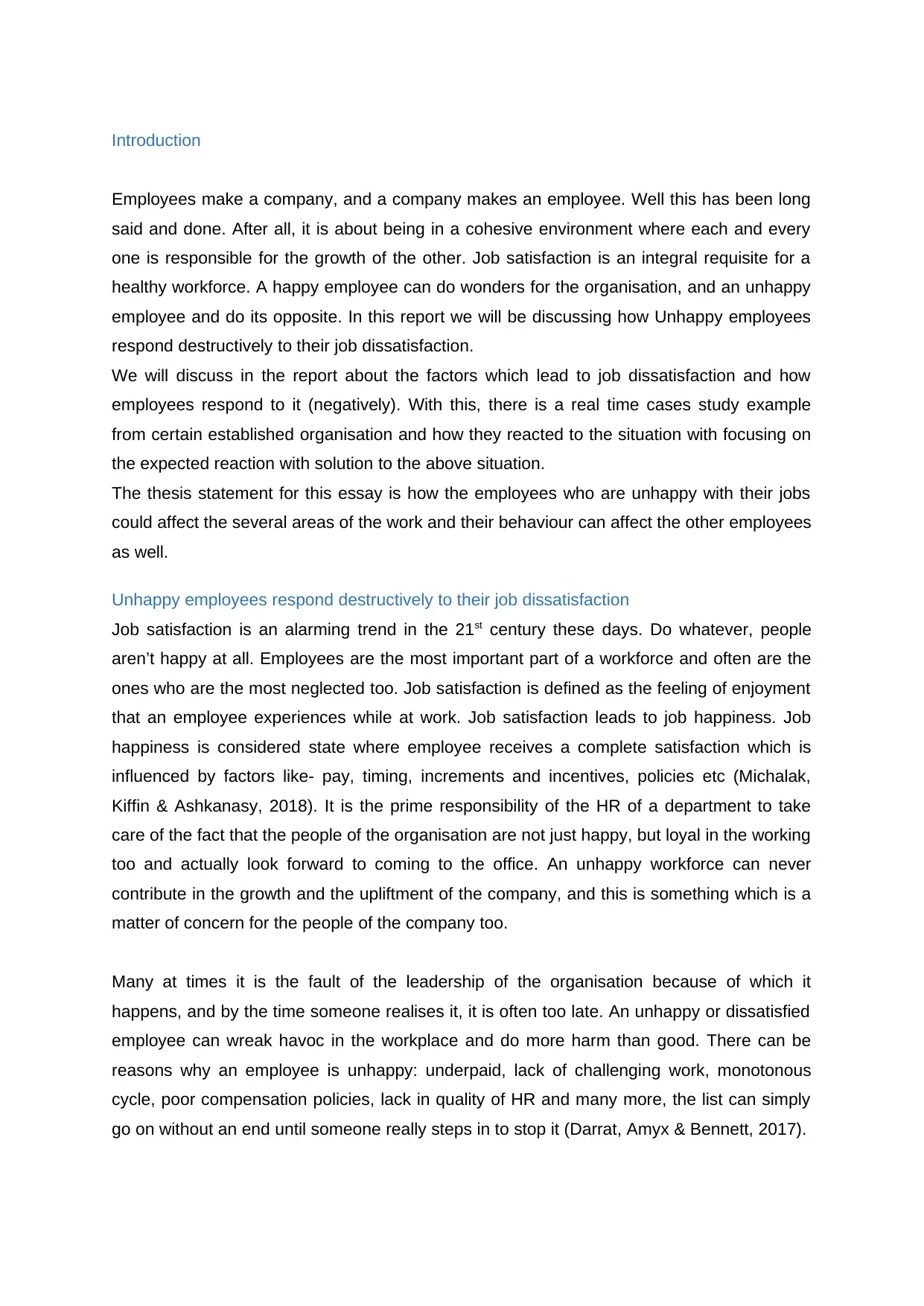
Introduction
Employees make a company, and a company makes an employee. Well this has been long
said and done. After all, it is about being in a cohesive environment where each and every
one is responsible for the growth of the other. Job satisfaction is an integral requisite for a
healthy workforce. A happy employee can do wonders for the organisation, and an unhappy
employee and do its opposite. In this report we will be discussing how Unhappy employees
respond destructively to their job dissatisfaction.
We will discuss in the report about the factors which lead to job dissatisfaction and how
employees respond to it (negatively). With this, there is a real time cases study example
from certain established organisation and how they reacted to the situation with focusing on
the expected reaction with solution to the above situation.
The thesis statement for this essay is how the employees who are unhappy with their jobs
could affect the several areas of the work and their behaviour can affect the other employees
as well.
Unhappy employees respond destructively to their job dissatisfaction
Job satisfaction is an alarming trend in the 21st century these days. Do whatever, people
aren’t happy at all. Employees are the most important part of a workforce and often are the
ones who are the most neglected too. Job satisfaction is defined as the feeling of enjoyment
that an employee experiences while at work. Job satisfaction leads to job happiness. Job
happiness is considered state where employee receives a complete satisfaction which is
influenced by factors like- pay, timing, increments and incentives, policies etc (Michalak,
Kiffin & Ashkanasy, 2018). It is the prime responsibility of the HR of a department to take
care of the fact that the people of the organisation are not just happy, but loyal in the working
too and actually look forward to coming to the office. An unhappy workforce can never
contribute in the growth and the upliftment of the company, and this is something which is a
matter of concern for the people of the company too.
Many at times it is the fault of the leadership of the organisation because of which it
happens, and by the time someone realises it, it is often too late. An unhappy or dissatisfied
employee can wreak havoc in the workplace and do more harm than good. There can be
reasons why an employee is unhappy: underpaid, lack of challenging work, monotonous
cycle, poor compensation policies, lack in quality of HR and many more, the list can simply
go on without an end until someone really steps in to stop it (Darrat, Amyx & Bennett, 2017).
Employees make a company, and a company makes an employee. Well this has been long
said and done. After all, it is about being in a cohesive environment where each and every
one is responsible for the growth of the other. Job satisfaction is an integral requisite for a
healthy workforce. A happy employee can do wonders for the organisation, and an unhappy
employee and do its opposite. In this report we will be discussing how Unhappy employees
respond destructively to their job dissatisfaction.
We will discuss in the report about the factors which lead to job dissatisfaction and how
employees respond to it (negatively). With this, there is a real time cases study example
from certain established organisation and how they reacted to the situation with focusing on
the expected reaction with solution to the above situation.
The thesis statement for this essay is how the employees who are unhappy with their jobs
could affect the several areas of the work and their behaviour can affect the other employees
as well.
Unhappy employees respond destructively to their job dissatisfaction
Job satisfaction is an alarming trend in the 21st century these days. Do whatever, people
aren’t happy at all. Employees are the most important part of a workforce and often are the
ones who are the most neglected too. Job satisfaction is defined as the feeling of enjoyment
that an employee experiences while at work. Job satisfaction leads to job happiness. Job
happiness is considered state where employee receives a complete satisfaction which is
influenced by factors like- pay, timing, increments and incentives, policies etc (Michalak,
Kiffin & Ashkanasy, 2018). It is the prime responsibility of the HR of a department to take
care of the fact that the people of the organisation are not just happy, but loyal in the working
too and actually look forward to coming to the office. An unhappy workforce can never
contribute in the growth and the upliftment of the company, and this is something which is a
matter of concern for the people of the company too.
Many at times it is the fault of the leadership of the organisation because of which it
happens, and by the time someone realises it, it is often too late. An unhappy or dissatisfied
employee can wreak havoc in the workplace and do more harm than good. There can be
reasons why an employee is unhappy: underpaid, lack of challenging work, monotonous
cycle, poor compensation policies, lack in quality of HR and many more, the list can simply
go on without an end until someone really steps in to stop it (Darrat, Amyx & Bennett, 2017).
⊘ This is a preview!⊘
Do you want full access?
Subscribe today to unlock all pages.

Trusted by 1+ million students worldwide
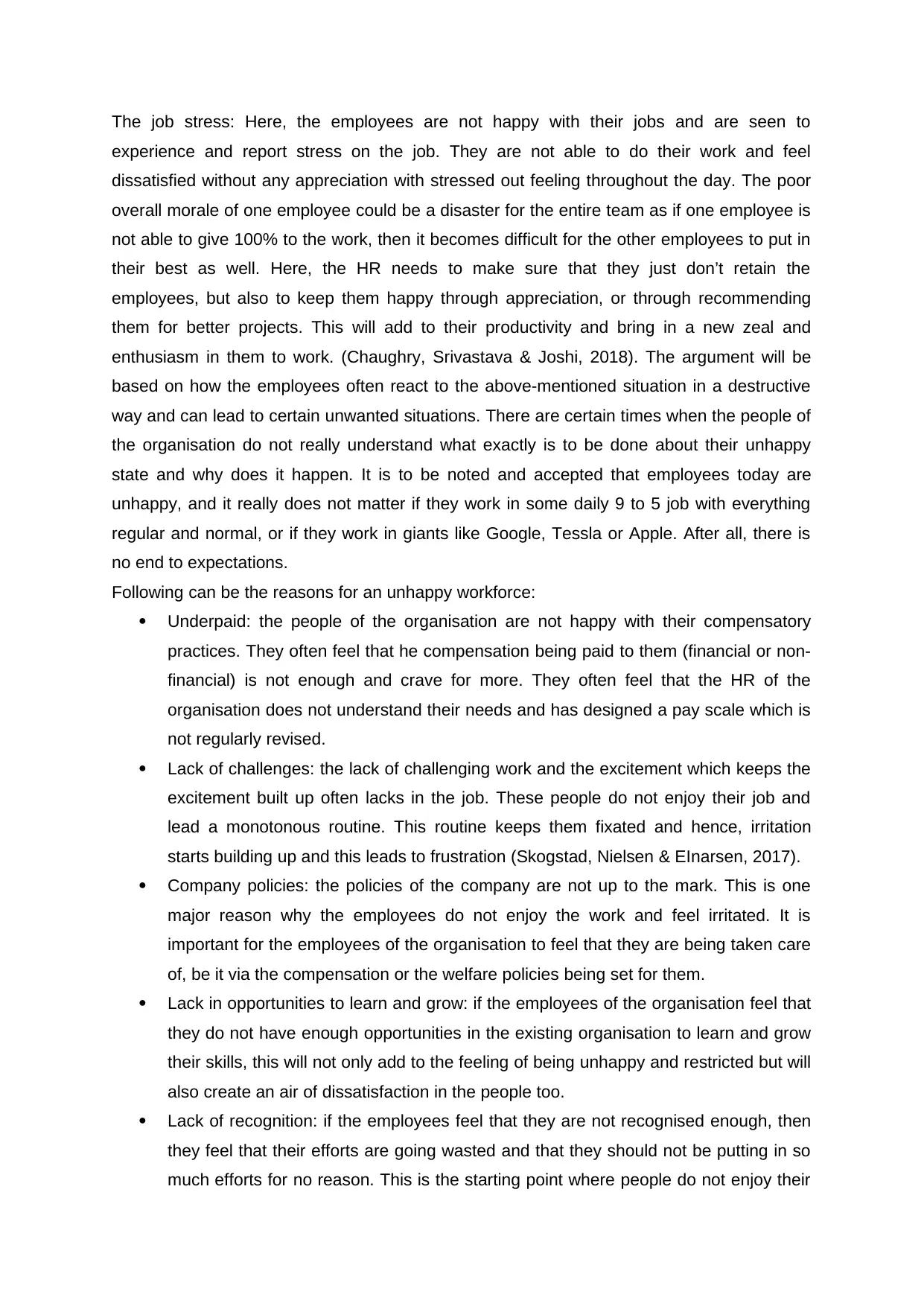
The job stress: Here, the employees are not happy with their jobs and are seen to
experience and report stress on the job. They are not able to do their work and feel
dissatisfied without any appreciation with stressed out feeling throughout the day. The poor
overall morale of one employee could be a disaster for the entire team as if one employee is
not able to give 100% to the work, then it becomes difficult for the other employees to put in
their best as well. Here, the HR needs to make sure that they just don’t retain the
employees, but also to keep them happy through appreciation, or through recommending
them for better projects. This will add to their productivity and bring in a new zeal and
enthusiasm in them to work. (Chaughry, Srivastava & Joshi, 2018). The argument will be
based on how the employees often react to the above-mentioned situation in a destructive
way and can lead to certain unwanted situations. There are certain times when the people of
the organisation do not really understand what exactly is to be done about their unhappy
state and why does it happen. It is to be noted and accepted that employees today are
unhappy, and it really does not matter if they work in some daily 9 to 5 job with everything
regular and normal, or if they work in giants like Google, Tessla or Apple. After all, there is
no end to expectations.
Following can be the reasons for an unhappy workforce:
Underpaid: the people of the organisation are not happy with their compensatory
practices. They often feel that he compensation being paid to them (financial or non-
financial) is not enough and crave for more. They often feel that the HR of the
organisation does not understand their needs and has designed a pay scale which is
not regularly revised.
Lack of challenges: the lack of challenging work and the excitement which keeps the
excitement built up often lacks in the job. These people do not enjoy their job and
lead a monotonous routine. This routine keeps them fixated and hence, irritation
starts building up and this leads to frustration (Skogstad, Nielsen & EInarsen, 2017).
Company policies: the policies of the company are not up to the mark. This is one
major reason why the employees do not enjoy the work and feel irritated. It is
important for the employees of the organisation to feel that they are being taken care
of, be it via the compensation or the welfare policies being set for them.
Lack in opportunities to learn and grow: if the employees of the organisation feel that
they do not have enough opportunities in the existing organisation to learn and grow
their skills, this will not only add to the feeling of being unhappy and restricted but will
also create an air of dissatisfaction in the people too.
Lack of recognition: if the employees feel that they are not recognised enough, then
they feel that their efforts are going wasted and that they should not be putting in so
much efforts for no reason. This is the starting point where people do not enjoy their
experience and report stress on the job. They are not able to do their work and feel
dissatisfied without any appreciation with stressed out feeling throughout the day. The poor
overall morale of one employee could be a disaster for the entire team as if one employee is
not able to give 100% to the work, then it becomes difficult for the other employees to put in
their best as well. Here, the HR needs to make sure that they just don’t retain the
employees, but also to keep them happy through appreciation, or through recommending
them for better projects. This will add to their productivity and bring in a new zeal and
enthusiasm in them to work. (Chaughry, Srivastava & Joshi, 2018). The argument will be
based on how the employees often react to the above-mentioned situation in a destructive
way and can lead to certain unwanted situations. There are certain times when the people of
the organisation do not really understand what exactly is to be done about their unhappy
state and why does it happen. It is to be noted and accepted that employees today are
unhappy, and it really does not matter if they work in some daily 9 to 5 job with everything
regular and normal, or if they work in giants like Google, Tessla or Apple. After all, there is
no end to expectations.
Following can be the reasons for an unhappy workforce:
Underpaid: the people of the organisation are not happy with their compensatory
practices. They often feel that he compensation being paid to them (financial or non-
financial) is not enough and crave for more. They often feel that the HR of the
organisation does not understand their needs and has designed a pay scale which is
not regularly revised.
Lack of challenges: the lack of challenging work and the excitement which keeps the
excitement built up often lacks in the job. These people do not enjoy their job and
lead a monotonous routine. This routine keeps them fixated and hence, irritation
starts building up and this leads to frustration (Skogstad, Nielsen & EInarsen, 2017).
Company policies: the policies of the company are not up to the mark. This is one
major reason why the employees do not enjoy the work and feel irritated. It is
important for the employees of the organisation to feel that they are being taken care
of, be it via the compensation or the welfare policies being set for them.
Lack in opportunities to learn and grow: if the employees of the organisation feel that
they do not have enough opportunities in the existing organisation to learn and grow
their skills, this will not only add to the feeling of being unhappy and restricted but will
also create an air of dissatisfaction in the people too.
Lack of recognition: if the employees feel that they are not recognised enough, then
they feel that their efforts are going wasted and that they should not be putting in so
much efforts for no reason. This is the starting point where people do not enjoy their
Paraphrase This Document
Need a fresh take? Get an instant paraphrase of this document with our AI Paraphraser
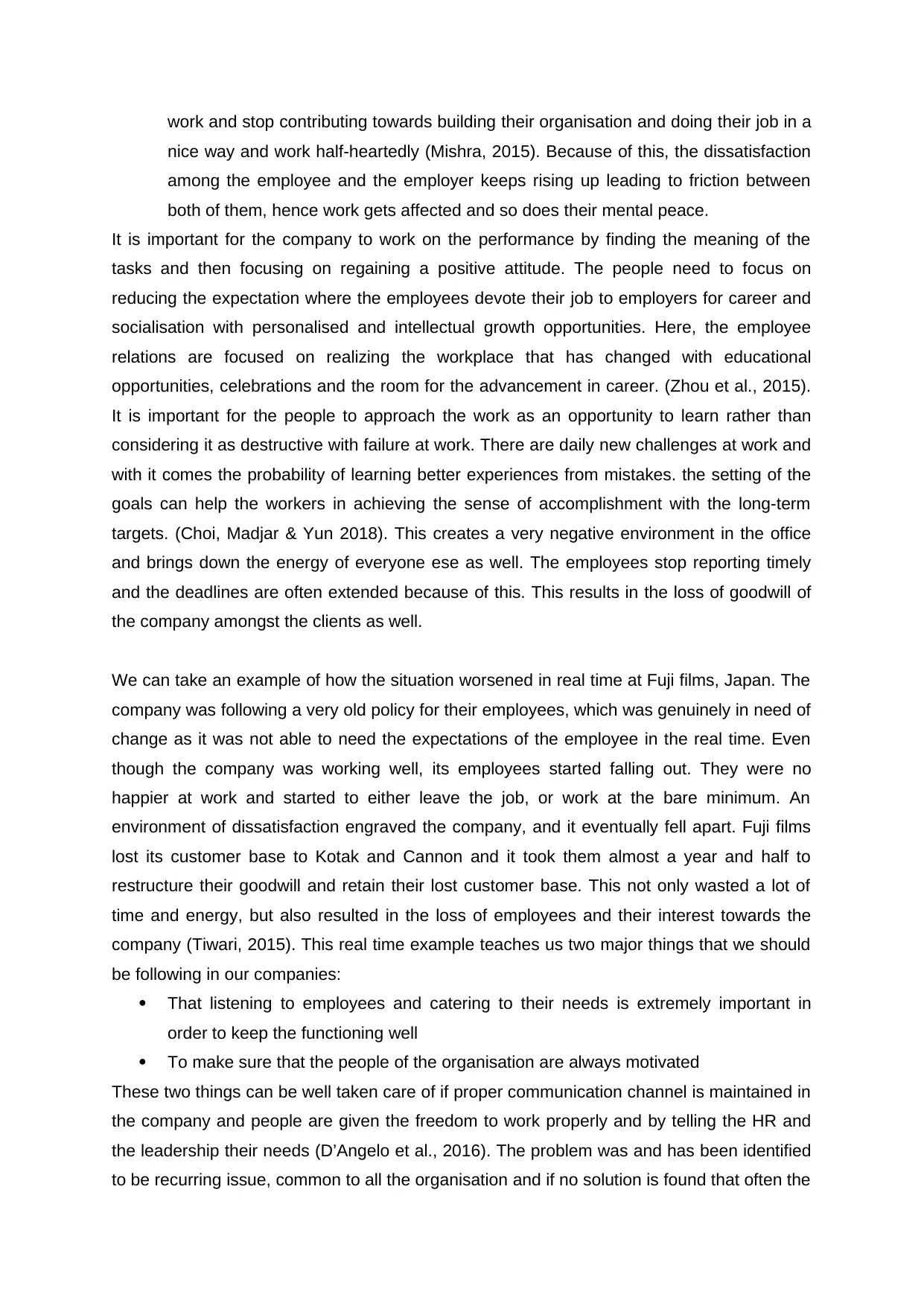
work and stop contributing towards building their organisation and doing their job in a
nice way and work half-heartedly (Mishra, 2015). Because of this, the dissatisfaction
among the employee and the employer keeps rising up leading to friction between
both of them, hence work gets affected and so does their mental peace.
It is important for the company to work on the performance by finding the meaning of the
tasks and then focusing on regaining a positive attitude. The people need to focus on
reducing the expectation where the employees devote their job to employers for career and
socialisation with personalised and intellectual growth opportunities. Here, the employee
relations are focused on realizing the workplace that has changed with educational
opportunities, celebrations and the room for the advancement in career. (Zhou et al., 2015).
It is important for the people to approach the work as an opportunity to learn rather than
considering it as destructive with failure at work. There are daily new challenges at work and
with it comes the probability of learning better experiences from mistakes. the setting of the
goals can help the workers in achieving the sense of accomplishment with the long-term
targets. (Choi, Madjar & Yun 2018). This creates a very negative environment in the office
and brings down the energy of everyone ese as well. The employees stop reporting timely
and the deadlines are often extended because of this. This results in the loss of goodwill of
the company amongst the clients as well.
We can take an example of how the situation worsened in real time at Fuji films, Japan. The
company was following a very old policy for their employees, which was genuinely in need of
change as it was not able to need the expectations of the employee in the real time. Even
though the company was working well, its employees started falling out. They were no
happier at work and started to either leave the job, or work at the bare minimum. An
environment of dissatisfaction engraved the company, and it eventually fell apart. Fuji films
lost its customer base to Kotak and Cannon and it took them almost a year and half to
restructure their goodwill and retain their lost customer base. This not only wasted a lot of
time and energy, but also resulted in the loss of employees and their interest towards the
company (Tiwari, 2015). This real time example teaches us two major things that we should
be following in our companies:
That listening to employees and catering to their needs is extremely important in
order to keep the functioning well
To make sure that the people of the organisation are always motivated
These two things can be well taken care of if proper communication channel is maintained in
the company and people are given the freedom to work properly and by telling the HR and
the leadership their needs (D’Angelo et al., 2016). The problem was and has been identified
to be recurring issue, common to all the organisation and if no solution is found that often the
nice way and work half-heartedly (Mishra, 2015). Because of this, the dissatisfaction
among the employee and the employer keeps rising up leading to friction between
both of them, hence work gets affected and so does their mental peace.
It is important for the company to work on the performance by finding the meaning of the
tasks and then focusing on regaining a positive attitude. The people need to focus on
reducing the expectation where the employees devote their job to employers for career and
socialisation with personalised and intellectual growth opportunities. Here, the employee
relations are focused on realizing the workplace that has changed with educational
opportunities, celebrations and the room for the advancement in career. (Zhou et al., 2015).
It is important for the people to approach the work as an opportunity to learn rather than
considering it as destructive with failure at work. There are daily new challenges at work and
with it comes the probability of learning better experiences from mistakes. the setting of the
goals can help the workers in achieving the sense of accomplishment with the long-term
targets. (Choi, Madjar & Yun 2018). This creates a very negative environment in the office
and brings down the energy of everyone ese as well. The employees stop reporting timely
and the deadlines are often extended because of this. This results in the loss of goodwill of
the company amongst the clients as well.
We can take an example of how the situation worsened in real time at Fuji films, Japan. The
company was following a very old policy for their employees, which was genuinely in need of
change as it was not able to need the expectations of the employee in the real time. Even
though the company was working well, its employees started falling out. They were no
happier at work and started to either leave the job, or work at the bare minimum. An
environment of dissatisfaction engraved the company, and it eventually fell apart. Fuji films
lost its customer base to Kotak and Cannon and it took them almost a year and half to
restructure their goodwill and retain their lost customer base. This not only wasted a lot of
time and energy, but also resulted in the loss of employees and their interest towards the
company (Tiwari, 2015). This real time example teaches us two major things that we should
be following in our companies:
That listening to employees and catering to their needs is extremely important in
order to keep the functioning well
To make sure that the people of the organisation are always motivated
These two things can be well taken care of if proper communication channel is maintained in
the company and people are given the freedom to work properly and by telling the HR and
the leadership their needs (D’Angelo et al., 2016). The problem was and has been identified
to be recurring issue, common to all the organisation and if no solution is found that often the
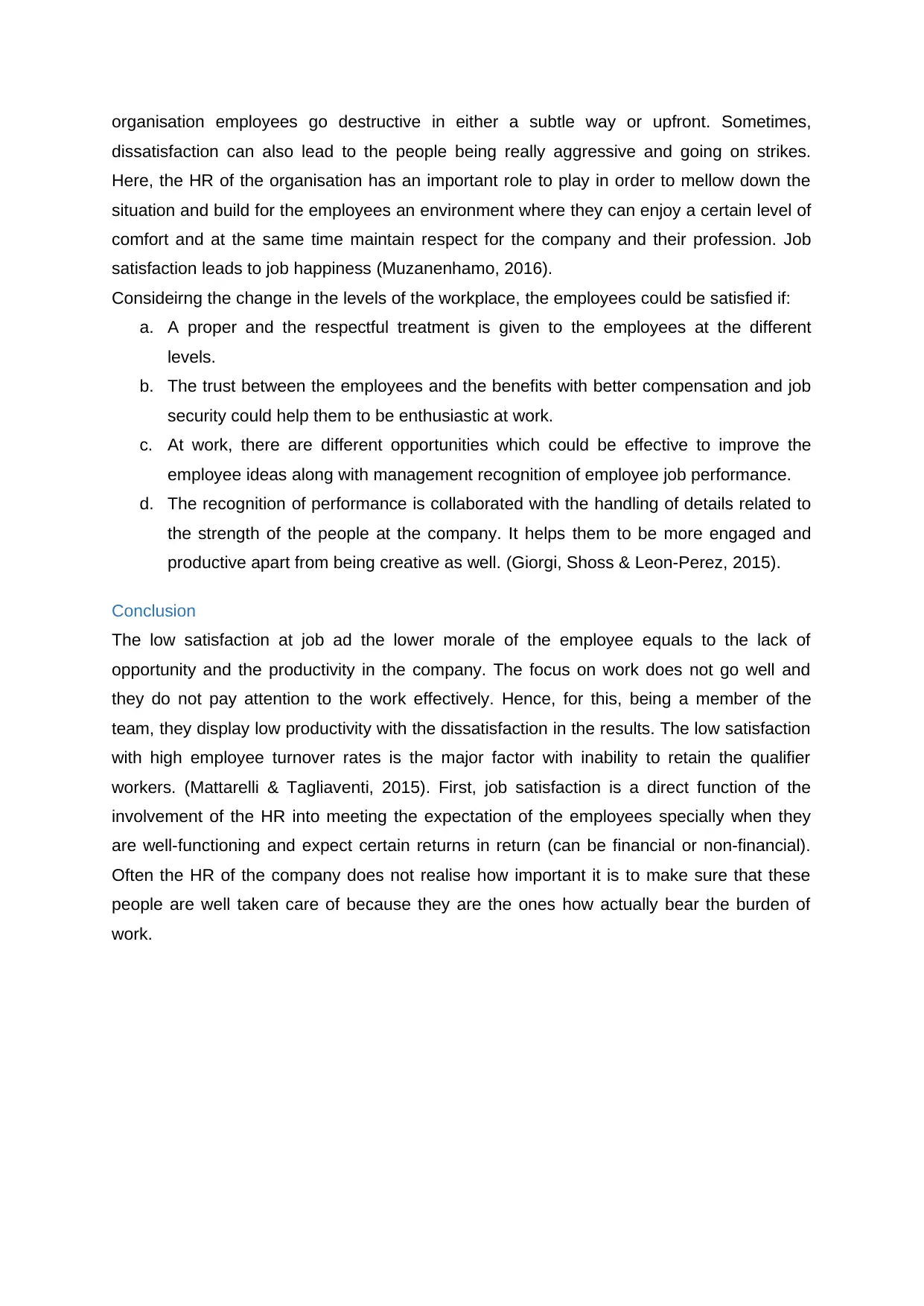
organisation employees go destructive in either a subtle way or upfront. Sometimes,
dissatisfaction can also lead to the people being really aggressive and going on strikes.
Here, the HR of the organisation has an important role to play in order to mellow down the
situation and build for the employees an environment where they can enjoy a certain level of
comfort and at the same time maintain respect for the company and their profession. Job
satisfaction leads to job happiness (Muzanenhamo, 2016).
Consideirng the change in the levels of the workplace, the employees could be satisfied if:
a. A proper and the respectful treatment is given to the employees at the different
levels.
b. The trust between the employees and the benefits with better compensation and job
security could help them to be enthusiastic at work.
c. At work, there are different opportunities which could be effective to improve the
employee ideas along with management recognition of employee job performance.
d. The recognition of performance is collaborated with the handling of details related to
the strength of the people at the company. It helps them to be more engaged and
productive apart from being creative as well. (Giorgi, Shoss & Leon-Perez, 2015).
Conclusion
The low satisfaction at job ad the lower morale of the employee equals to the lack of
opportunity and the productivity in the company. The focus on work does not go well and
they do not pay attention to the work effectively. Hence, for this, being a member of the
team, they display low productivity with the dissatisfaction in the results. The low satisfaction
with high employee turnover rates is the major factor with inability to retain the qualifier
workers. (Mattarelli & Tagliaventi, 2015). First, job satisfaction is a direct function of the
involvement of the HR into meeting the expectation of the employees specially when they
are well-functioning and expect certain returns in return (can be financial or non-financial).
Often the HR of the company does not realise how important it is to make sure that these
people are well taken care of because they are the ones how actually bear the burden of
work.
dissatisfaction can also lead to the people being really aggressive and going on strikes.
Here, the HR of the organisation has an important role to play in order to mellow down the
situation and build for the employees an environment where they can enjoy a certain level of
comfort and at the same time maintain respect for the company and their profession. Job
satisfaction leads to job happiness (Muzanenhamo, 2016).
Consideirng the change in the levels of the workplace, the employees could be satisfied if:
a. A proper and the respectful treatment is given to the employees at the different
levels.
b. The trust between the employees and the benefits with better compensation and job
security could help them to be enthusiastic at work.
c. At work, there are different opportunities which could be effective to improve the
employee ideas along with management recognition of employee job performance.
d. The recognition of performance is collaborated with the handling of details related to
the strength of the people at the company. It helps them to be more engaged and
productive apart from being creative as well. (Giorgi, Shoss & Leon-Perez, 2015).
Conclusion
The low satisfaction at job ad the lower morale of the employee equals to the lack of
opportunity and the productivity in the company. The focus on work does not go well and
they do not pay attention to the work effectively. Hence, for this, being a member of the
team, they display low productivity with the dissatisfaction in the results. The low satisfaction
with high employee turnover rates is the major factor with inability to retain the qualifier
workers. (Mattarelli & Tagliaventi, 2015). First, job satisfaction is a direct function of the
involvement of the HR into meeting the expectation of the employees specially when they
are well-functioning and expect certain returns in return (can be financial or non-financial).
Often the HR of the company does not realise how important it is to make sure that these
people are well taken care of because they are the ones how actually bear the burden of
work.
⊘ This is a preview!⊘
Do you want full access?
Subscribe today to unlock all pages.

Trusted by 1+ million students worldwide
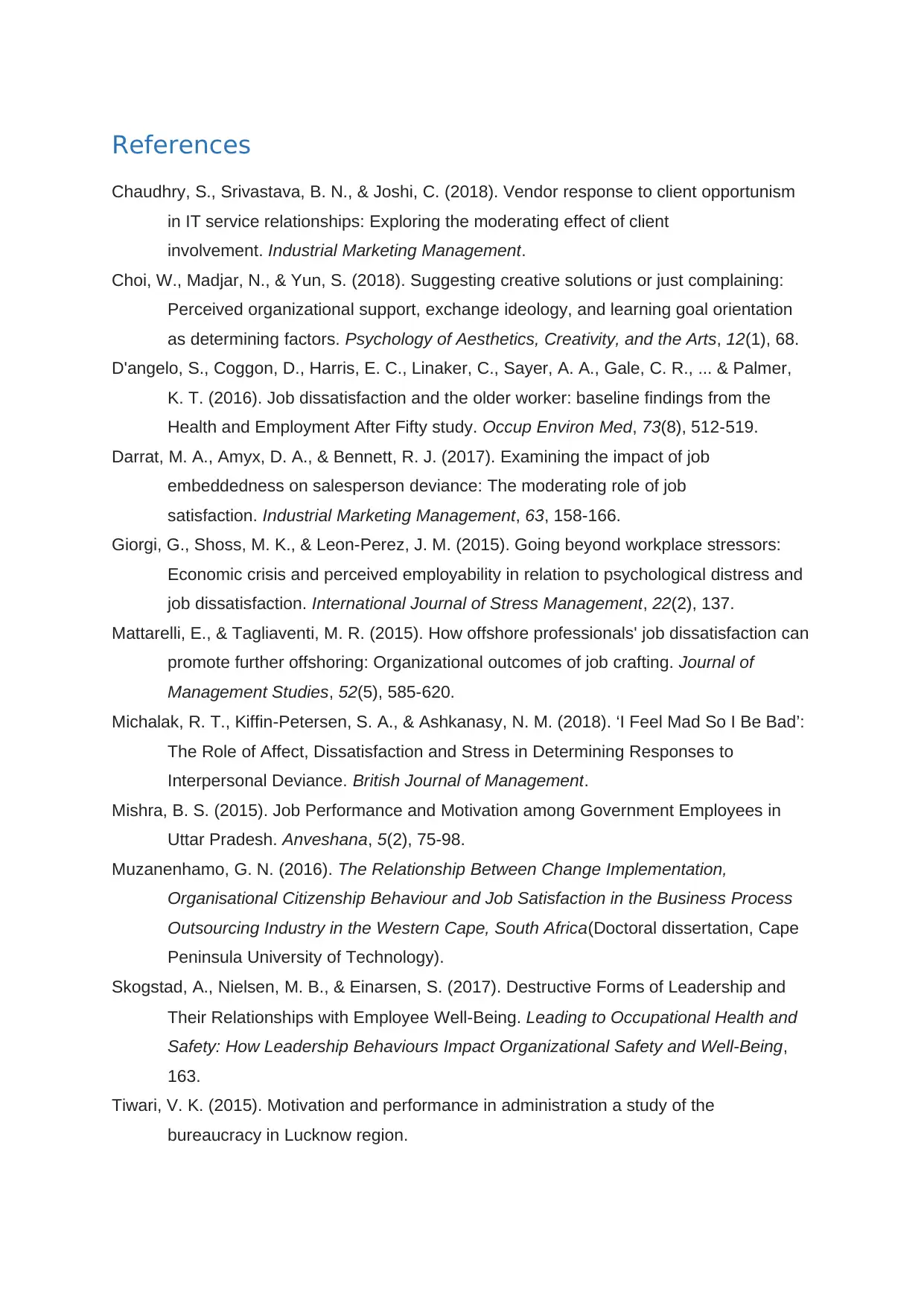
References
Chaudhry, S., Srivastava, B. N., & Joshi, C. (2018). Vendor response to client opportunism
in IT service relationships: Exploring the moderating effect of client
involvement. Industrial Marketing Management.
Choi, W., Madjar, N., & Yun, S. (2018). Suggesting creative solutions or just complaining:
Perceived organizational support, exchange ideology, and learning goal orientation
as determining factors. Psychology of Aesthetics, Creativity, and the Arts, 12(1), 68.
D'angelo, S., Coggon, D., Harris, E. C., Linaker, C., Sayer, A. A., Gale, C. R., ... & Palmer,
K. T. (2016). Job dissatisfaction and the older worker: baseline findings from the
Health and Employment After Fifty study. Occup Environ Med, 73(8), 512-519.
Darrat, M. A., Amyx, D. A., & Bennett, R. J. (2017). Examining the impact of job
embeddedness on salesperson deviance: The moderating role of job
satisfaction. Industrial Marketing Management, 63, 158-166.
Giorgi, G., Shoss, M. K., & Leon-Perez, J. M. (2015). Going beyond workplace stressors:
Economic crisis and perceived employability in relation to psychological distress and
job dissatisfaction. International Journal of Stress Management, 22(2), 137.
Mattarelli, E., & Tagliaventi, M. R. (2015). How offshore professionals' job dissatisfaction can
promote further offshoring: Organizational outcomes of job crafting. Journal of
Management Studies, 52(5), 585-620.
Michalak, R. T., Kiffin‐Petersen, S. A., & Ashkanasy, N. M. (2018). ‘I Feel Mad So I Be Bad’:
The Role of Affect, Dissatisfaction and Stress in Determining Responses to
Interpersonal Deviance. British Journal of Management.
Mishra, B. S. (2015). Job Performance and Motivation among Government Employees in
Uttar Pradesh. Anveshana, 5(2), 75-98.
Muzanenhamo, G. N. (2016). The Relationship Between Change Implementation,
Organisational Citizenship Behaviour and Job Satisfaction in the Business Process
Outsourcing Industry in the Western Cape, South Africa(Doctoral dissertation, Cape
Peninsula University of Technology).
Skogstad, A., Nielsen, M. B., & Einarsen, S. (2017). Destructive Forms of Leadership and
Their Relationships with Employee Well‐Being. Leading to Occupational Health and
Safety: How Leadership Behaviours Impact Organizational Safety and Well-Being,
163.
Tiwari, V. K. (2015). Motivation and performance in administration a study of the
bureaucracy in Lucknow region.
Chaudhry, S., Srivastava, B. N., & Joshi, C. (2018). Vendor response to client opportunism
in IT service relationships: Exploring the moderating effect of client
involvement. Industrial Marketing Management.
Choi, W., Madjar, N., & Yun, S. (2018). Suggesting creative solutions or just complaining:
Perceived organizational support, exchange ideology, and learning goal orientation
as determining factors. Psychology of Aesthetics, Creativity, and the Arts, 12(1), 68.
D'angelo, S., Coggon, D., Harris, E. C., Linaker, C., Sayer, A. A., Gale, C. R., ... & Palmer,
K. T. (2016). Job dissatisfaction and the older worker: baseline findings from the
Health and Employment After Fifty study. Occup Environ Med, 73(8), 512-519.
Darrat, M. A., Amyx, D. A., & Bennett, R. J. (2017). Examining the impact of job
embeddedness on salesperson deviance: The moderating role of job
satisfaction. Industrial Marketing Management, 63, 158-166.
Giorgi, G., Shoss, M. K., & Leon-Perez, J. M. (2015). Going beyond workplace stressors:
Economic crisis and perceived employability in relation to psychological distress and
job dissatisfaction. International Journal of Stress Management, 22(2), 137.
Mattarelli, E., & Tagliaventi, M. R. (2015). How offshore professionals' job dissatisfaction can
promote further offshoring: Organizational outcomes of job crafting. Journal of
Management Studies, 52(5), 585-620.
Michalak, R. T., Kiffin‐Petersen, S. A., & Ashkanasy, N. M. (2018). ‘I Feel Mad So I Be Bad’:
The Role of Affect, Dissatisfaction and Stress in Determining Responses to
Interpersonal Deviance. British Journal of Management.
Mishra, B. S. (2015). Job Performance and Motivation among Government Employees in
Uttar Pradesh. Anveshana, 5(2), 75-98.
Muzanenhamo, G. N. (2016). The Relationship Between Change Implementation,
Organisational Citizenship Behaviour and Job Satisfaction in the Business Process
Outsourcing Industry in the Western Cape, South Africa(Doctoral dissertation, Cape
Peninsula University of Technology).
Skogstad, A., Nielsen, M. B., & Einarsen, S. (2017). Destructive Forms of Leadership and
Their Relationships with Employee Well‐Being. Leading to Occupational Health and
Safety: How Leadership Behaviours Impact Organizational Safety and Well-Being,
163.
Tiwari, V. K. (2015). Motivation and performance in administration a study of the
bureaucracy in Lucknow region.
Paraphrase This Document
Need a fresh take? Get an instant paraphrase of this document with our AI Paraphraser

Zhou, W., He, G., Wang, H., He, Y., Yuan, Q., & Liu, D. (2015). Job dissatisfaction and
burnout of nurses in Hunan, China: A cross‐sectional survey. Nursing & health
sciences, 17(4), 444-450.
burnout of nurses in Hunan, China: A cross‐sectional survey. Nursing & health
sciences, 17(4), 444-450.
1 out of 8
Related Documents
Your All-in-One AI-Powered Toolkit for Academic Success.
+13062052269
info@desklib.com
Available 24*7 on WhatsApp / Email
![[object Object]](/_next/static/media/star-bottom.7253800d.svg)
Unlock your academic potential
Copyright © 2020–2025 A2Z Services. All Rights Reserved. Developed and managed by ZUCOL.





